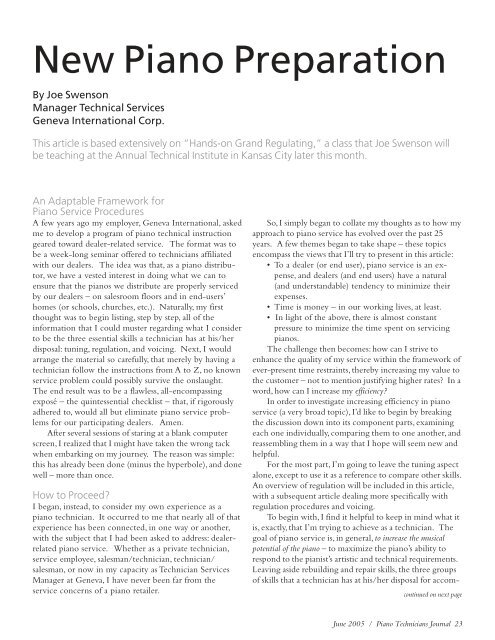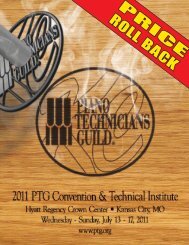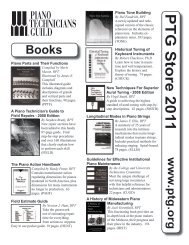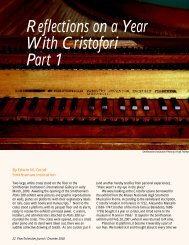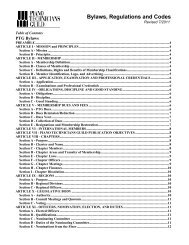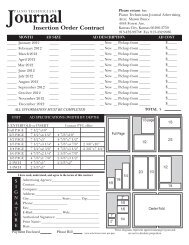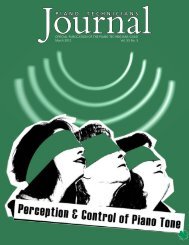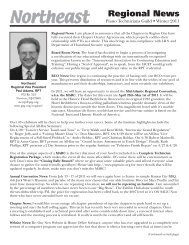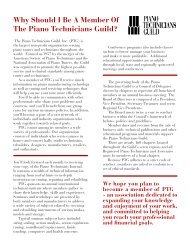Download PDF - Piano Technicians Guild
Download PDF - Piano Technicians Guild
Download PDF - Piano Technicians Guild
You also want an ePaper? Increase the reach of your titles
YUMPU automatically turns print PDFs into web optimized ePapers that Google loves.
New <strong>Piano</strong> Preparation<br />
By Joe Swenson<br />
Manager Technical Services<br />
Geneva International Corp.<br />
This article is based extensively on “Hands-on Grand Regulating,” a class that Joe Swenson will<br />
be teaching at the Annual Technical Institute in Kansas City later this month.<br />
An Adaptable Framework for<br />
<strong>Piano</strong> Service Procedures<br />
A few years ago my employer, Geneva International, asked<br />
me to develop a program of piano technical instruction<br />
geared toward dealer-related service. The format was to<br />
be a week-long seminar offered to technicians affiliated<br />
with our dealers. The idea was that, as a piano distributor,<br />
we have a vested interest in doing what we can to<br />
ensure that the pianos we distribute are properly serviced<br />
by our dealers – on salesroom floors and in end-users’<br />
homes (or schools, churches, etc.). Naturally, my first<br />
thought was to begin listing, step by step, all of the<br />
information that I could muster regarding what I consider<br />
to be the three essential skills a technician has at his/her<br />
disposal: tuning, regulation, and voicing. Next, I would<br />
arrange the material so carefully, that merely by having a<br />
technician follow the instructions from A to Z, no known<br />
service problem could possibly survive the onslaught.<br />
The end result was to be a flawless, all-encompassing<br />
exposé – the quintessential checklist – that, if rigorously<br />
adhered to, would all but eliminate piano service problems<br />
for our participating dealers. Amen.<br />
After several sessions of staring at a blank computer<br />
screen, I realized that I might have taken the wrong tack<br />
when embarking on my journey. The reason was simple:<br />
this has already been done (minus the hyperbole), and done<br />
well – more than once.<br />
How to Proceed?<br />
I began, instead, to consider my own experience as a<br />
piano technician. It occurred to me that nearly all of that<br />
experience has been connected, in one way or another,<br />
with the subject that I had been asked to address: dealerrelated<br />
piano service. Whether as a private technician,<br />
service employee, salesman/technician, technician/<br />
salesman, or now in my capacity as Technician Services<br />
Manager at Geneva, I have never been far from the<br />
service concerns of a piano retailer.<br />
So, I simply began to collate my thoughts as to how my<br />
approach to piano service has evolved over the past 25<br />
years. A few themes began to take shape – these topics<br />
encompass the views that I’ll try to present in this article:<br />
• To a dealer (or end user), piano service is an expense,<br />
and dealers (and end users) have a natural<br />
(and understandable) tendency to minimize their<br />
expenses.<br />
• Time is money – in our working lives, at least.<br />
• In light of the above, there is almost constant<br />
pressure to minimize the time spent on servicing<br />
pianos.<br />
The challenge then becomes: how can I strive to<br />
enhance the quality of my service within the framework of<br />
ever-present time restraints, thereby increasing my value to<br />
the customer – not to mention justifying higher rates? In a<br />
word, how can I increase my efficiency?<br />
In order to investigate increasing efficiency in piano<br />
service (a very broad topic), I’d like to begin by breaking<br />
the discussion down into its component parts, examining<br />
each one individually, comparing them to one another, and<br />
reassembling them in a way that I hope will seem new and<br />
helpful.<br />
For the most part, I’m going to leave the tuning aspect<br />
alone, except to use it as a reference to compare other skills.<br />
An overview of regulation will be included in this article,<br />
with a subsequent article dealing more specifically with<br />
regulation procedures and voicing.<br />
To begin with, I find it helpful to keep in mind what it<br />
is, exactly, that I’m trying to achieve as a technician. The<br />
goal of piano service is, in general, to increase the musical<br />
potential of the piano – to maximize the piano’s ability to<br />
respond to the pianist’s artistic and technical requirements.<br />
Leaving aside rebuilding and repair skills, the three groups<br />
of skills that a technician has at his/her disposal for accom-<br />
continued on next page<br />
June 2005 / <strong>Piano</strong> <strong>Technicians</strong> Journal 23
New <strong>Piano</strong> Preparation<br />
continued from previous page<br />
plishing this goal are tuning, regulation, and voicing.<br />
Three Fundamental Skills<br />
Of these three skills tuning, in some respects, is the least<br />
problematic. Although the skill of piano tuning is highly<br />
complex, in both theory and practice, it possesses one<br />
simplifying feature that the other two disciplines lack: an<br />
entirely objective reference – one that exists outside the<br />
piano itself. This reference usually is A4=440Hz. All<br />
decisions made by the tuner, at any point in the tuning<br />
process, can be judged by their relationship to this universally<br />
agreed-upon point of departure.<br />
At the other end of the spectrum is voicing. The<br />
voicer has no such standard of orientation; all judgments<br />
are purely subjective. The overriding authority is one’s<br />
own assessment of what constitutes good piano tone. The<br />
ability to make these judgments can only be developed<br />
with experience. Studying the physical properties of both<br />
hammer and strings, listening astutely to piano performances,<br />
and observing other voicers’ techniques are all<br />
recommended as methods of developing this skill.<br />
In terms of objective orientation, regulation lies<br />
somewhere between tuning and voicing. There are<br />
objective references, e.g., key height = 64mm, but they<br />
exist only in the engineer’s drawings. By the time the<br />
piano is assembled, none of these references can be trusted<br />
with absolute assurance. Once again, skill and experience<br />
Chart 1 — Steps in the process of playing the piano. The steps influenced by<br />
the piano technician are bracketed in red. This chart is adapted from one by<br />
Dr. Donald Hall (see endnote (1). Used by permission.<br />
are needed to accurately define certain parameters that<br />
allow a particular piano to perform at its best. These<br />
parameters take the form of mechanical relationships rather<br />
than precise numerical values.<br />
Ideally, a piano technician is equally proficient in all<br />
three of these skills.<br />
Chart 1 shows a chart (with some additions in red)<br />
used by physicist Donald Hall in his lecture “The Hammer<br />
and the String.” 1 I have added the red brackets to indicate<br />
those segments of the playing process over which the<br />
technician has some control. The piano builder or<br />
rebuilder can extend this bracket to include soundboard<br />
motion.<br />
Referring to this chart, the effect of the technician’s<br />
work begins the instant the key is set in motion (lever<br />
action), and ends when the string vibration is transferred to<br />
the bridge (force on bridge). Regulation directly affects<br />
hammer motion. Tuning affects string motion. Voicing<br />
determines the physical condition of both hammers and<br />
strings when the two meet during the striking process. In<br />
the progression illustrated in Chart 1, voicing literally<br />
connects regulation and tuning. A thorough understanding<br />
of all three skills, and how they relate to one another, will<br />
enhance the technician’s ability to make judgments involving<br />
each one individually and enable the technician to<br />
make the most of his/her time (and the customer’s money).<br />
Regulation<br />
Taken as a whole, the object of the regulation process is<br />
easy to describe. The short paragraph below neatly<br />
brings together all facets of regulation and can serve as a<br />
definition of the entire procedure:<br />
When a piano is played, mechanical energy is imparted by<br />
the pianist into the front of the key. This energy is used to<br />
propel the hammer, via a system of levers, into the string,<br />
initiating the piano’s tone. The purpose of regulation is to<br />
minimize the loss of energy to this system, giving the player<br />
as much control as possible over the velocity of the hammer.<br />
The concept of the entire process then, is simple. The<br />
number of steps, and therefore the number of separate skills<br />
needed to complete the regulation process, and the interactive<br />
nature of these steps are what make the task seem<br />
daunting. Taken individually, none of these skills is<br />
particularly difficult to master. How all of these steps relate<br />
to one another, and to the system’s overall efficiency, is a<br />
more complex issue. Although there is a certain logical<br />
progression to the steps involved in regulation, any attempt<br />
to compile a comprehensive, ordered list of these procedures<br />
that will yield consistently high-quality results if<br />
followed precisely is bound to be both extremely lengthy<br />
24 <strong>Piano</strong> <strong>Technicians</strong> Journal / June 2005
and inefficient in practice. Every service situation is<br />
unique. Ever-present time restraints force technicians to<br />
make judgments on which procedures to focus, and what<br />
degree of perfection can be attained in the time allowed.<br />
It may be useful here to draw an analogy with the<br />
tuning process. When learning to tune (aurally), we<br />
generally follow someone else’s written list of steps – a<br />
“bearing plan” – when setting a temperament. Along with<br />
these plans, there are usually a greater or lesser number of<br />
notes regarding checks and explanations for these steps. At<br />
first, we continually refer to this plan and compare our<br />
progress to it by using the accompanying notes. As time<br />
Table 1<br />
goes on, we wean ourselves from having to refer to others’<br />
instructions and learn to make our own judgments “on the<br />
fly.” When we reach a certain level of maturity as a tuner,<br />
we realize that no two tuning situations are identical, and<br />
we are unconsciously altering our learned procedures in<br />
order to manage the situation at hand. If an experienced<br />
tuner were to write down his/her entire thought process<br />
on any given tuning, it would encompass volumes, and it<br />
would differ significantly from the same type of description<br />
the tuner might give for another of his/her own tunings.<br />
The point is that, without even being consciously<br />
aware of it, we are constantly recreating our own “bearing<br />
continued on next page<br />
The logic behind the order of these four<br />
categories can be summed up as follows:<br />
1) Action Preparation – Action components are cleaned, secured or firmly<br />
mated (as with the key-bed to key-frame arrangement).<br />
2) Friction – Areas of excess friction are discovered and corrected. Excessive<br />
friction is that which causes an action part to impair the mechanical<br />
efficiency of a key, damper, etc. to a musically significant extent.<br />
3) Alignment – These procedures involve the arrangement of action<br />
components in such a way that the transfer of energy from part to part<br />
is most efficient. The nature of these procedures differs from the<br />
nature of the regulation procedures in that their placement is either<br />
right, or it’s wrong – at least within the framework of a particular action.<br />
As examples, a hammer shank is either moving straight up and down,<br />
or it’s not; the key-set is either perfectly level, or it’s not; etc.…<br />
4) Regulation - By contrast, regulation procedures can take on a range of<br />
values, and what is “correct” can often be dictated by circumstance, or<br />
simply be a matter of taste. The ranges of acceptable values for these<br />
procedures fall within narrow, well-defined limits. Even these small<br />
variables, though, when manipulated, can effect profound changes to<br />
the response of the piano.<br />
This brief outline should be viewed as a “bearing plan” for regulation<br />
– a tool to use for the development of a foundation of efficient and<br />
confident regulation.<br />
Table 1 also illustrates a design for an order of steps that can be used in<br />
situations where a “complete” prep is required – and adequate time is<br />
allotted. As an illustration of how these ideas can be applied to this<br />
specific case, the procedures in each of the four categories are split into<br />
two groups. Those that are not highlighted in yellow can all be completed<br />
at the beginning, with the action removed from the piano. They can be<br />
thought of as representing a first pass through the “four steps.” The<br />
procedures that are highlighted in yellow must be performed with the<br />
action in the piano, and represent the second pass through the “four steps.”<br />
June 2005 / <strong>Piano</strong> <strong>Technicians</strong> Journal 25
New <strong>Piano</strong> Preparation<br />
continued from previous page<br />
plans,” and referring to our own “notes” that have accumulated<br />
over years of experience and study. All of this<br />
happens more or less instantaneously. When an experienced<br />
tuner examines a piano to be tuned, he/she can<br />
make what amounts to an extremely complex diagnosis<br />
within a matter of seconds. All matters of pitch adjustment,<br />
pin tightness, and character of sound are quickly<br />
analyzed, and, by the time we sit down to actually do the<br />
work, we know exactly what to do and are able to adjust<br />
our procedures to meet whatever time restriction exists for<br />
that particular job. No longer having to refer to anyone’s<br />
notes or checklists, we can stay several steps ahead of<br />
ourselves. There’s nothing extraordinary about this; as<br />
piano tuners, that’s our job.<br />
I believe that the ability to make quick, complex<br />
judgments as to the proper course of action is generally<br />
more apparent within the subject of tuning than it is with<br />
regulation. Part of the reason for this is that most technicians<br />
have performed far fewer complete regulations than<br />
they have tunings. This lack of experience can lead to an<br />
incomplete awareness of the musical value of proper<br />
regulation. The fact is that, within a given time frame,<br />
time spent regulating a piano can often effect a greater<br />
musical improvement to the piano than, say, voicing can.<br />
(As we’ll see later, the quality of voicing is actually dependent,<br />
to a significant degree, on the quality of regulation.)<br />
Sometimes the opposite is true, but the ability to quickly<br />
assess a situation and make decisions as to how to invest<br />
your time is a crucial skill for an efficient, and therefore<br />
valuable, technician.<br />
The “Four Steps” of Regulation<br />
The ability to perform efficient regulation is predicated<br />
on the development of two separate disciplines: the<br />
mastery of each individual skill and a thorough understanding<br />
of how these skills combine to produce a desired<br />
overall effect. With practice, and some instruction,<br />
mastering individual regulation skills will take care of<br />
itself. Developing an understanding of the interrelation<br />
of these steps and learning to apply this information to<br />
improve efficiency are matters that are, by nature, considerably<br />
less clear-cut. For this reason I have simplified the<br />
entire process by placing all of the individual procedures<br />
into four distinct categories (see Table 1):<br />
• Action preparation<br />
• Friction<br />
• Alignment<br />
• Regulation<br />
Taking a list of procedures normally associated with<br />
regulation, each separate procedure can be distributed into<br />
one of these four categories. In a general way, these four<br />
categories follow one another in sequence – the completion<br />
of each category laying a foundation for the next.<br />
Now we can begin to think of “regulation” adjustments as<br />
simply different facets of just four steps. One advantage of<br />
this arrangement can be illustrated by using it to help<br />
analyze an action intended for regulation: using the list<br />
below, a thorough analysis can be made by drawing on just<br />
four well-ordered observations. The analysis is a vital<br />
component of regulation, and will be examined, along with<br />
other regulation procedures, in the next article.<br />
A Final Thought<br />
Every time I’ve presented this material, whether at the<br />
seminar held in our offices in Wheeling, Illinois, or at<br />
various <strong>Guild</strong> conventions, at least a few participants have<br />
argued that certain procedures should be placed in<br />
different categories, or that the distinction made between<br />
alignment and regulation procedures is too rigid … and<br />
there are others. This is exactly the kind of response that<br />
I look for! It helps me underscore the crux of the matter.<br />
None of this material is designed to be rigid – quite the<br />
opposite. It is intended as a device to help the technician<br />
gather his or her own knowledge and experience, sort it<br />
out as they see fit, and focus it on the task at hand – all<br />
taking into account their own tastes and abilities. It’s a<br />
little like the opening in a game of chess. Opening<br />
sequences (and their variations) are studied and memorized<br />
through a string of 15 moves – or more. Rarely,<br />
however, is your opponent polite enough to follow along<br />
with your plan for more than a few moves. When the<br />
inevitable wrench is thrown into your planned opening,<br />
you don’t discard the plan, you simply alter it in order to<br />
adapt to the situation at hand. This analogy serves a<br />
purpose, but it breaks down rather quickly. I don’t, for<br />
example, like to think of the piano as my “opponent.” On<br />
second thought, there are times … but that’s an entirely<br />
different subject.<br />
Notes<br />
1<br />
“The Hammer and the String,” by Donald E. Hall.<br />
Five Lectures on the Acoustics of the <strong>Piano</strong>, edited by Anders<br />
Askenfelt. Royal Swedish Academy of Music No. 64,<br />
Stockholm, 1990. In the context of his lecture, Dr. Hall<br />
uses this chart (p. 59) to illustrate concepts viewed from the<br />
perspective of a physicist. I use it here because I find it a<br />
very useful tool in putting our work as technicians into<br />
perspective.<br />
26 <strong>Piano</strong> <strong>Technicians</strong> Journal / June 2005


